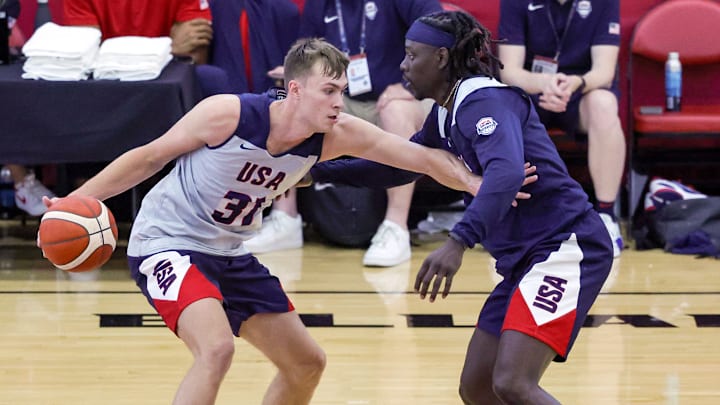In 1992, Olympic basketball changed forever when NBA players were allowed to participate and the Dream Team dominated the rest of the world. Since then, Team USA has won the gold medal at seven of the eight Olympic Games, only settling for the bronze in the 2004 Athens Olympic Games.
This year’s Olympic team, like the Dream Team in 1992, straddles two eras, with stars from the past era, LeBron James, Steph Curry, and Kevin Durant, being joined by the next wave of NBA talent, Anthony Edwards, Jayson Tatum, and Devin Booker. However, when it was just the young stars, the best American college basketball players, the US still won gold at nine of the first 12 Olympic Games that featured basketball, from 1936 in Berlin to 1988 in Seoul when the Soviet Union beat the Americans and forced the NBA’s best into action.
The professionals on Team USA, coming off a 101-100 win over South Sudan as 43.5-point favorites in a tune-up game before the 2024 Paris Olympic Games, could struggle to take home the gold medal this summer. That makes it a tough argument for the US to turn back to the collegiates, but maybe a cohesive team of young studs, not veterans all jockeying for legacy points, could compete well against the rest of the world.
It’s at least worth exploring what that roster would look like. This roster, as the rosters were before 1992, will be comprised of returning college basketball players and those who are entering the NBA, but have yet to begin their professional careers.
A 6-foot-1 undersized lefty, Mark Sears drew plenty of comparisons to Jalen Brunson with his performance in the 2023-24 season and while Brunson was left off Team USA, Sears would be a lock at the team’s point guard spot.
The former Ohio transfer averaged 21.5 points, with four assists and four rebounds a game while shooting 50.8% from the field and 43.6% from three on 5.9 attempts a game. Sears was excellent in the biggest games of the season, a rising star throughout March Madness as he led Nate Oats’ Alabama Crimson Tide to the Final Four. Even against UConn, Sears posted 24 points, three assists, and five rebounds on 9-14 from the field.
With Sears as the primary playmaker and providing elite floor spacing as a long-range shooter, Dalton Knecht, the SEC Player of the Year, will have plenty of space to attack and will be the No. 1 option for this hypothetical Team USA offense.
Knecht, a 40% three-point shooter, was the No. 17 overall pick in this summer’s NBA Draft, but he’s more than just a shooter. At 6-foot-6, Knecht was a true three-level scorer for Rick Barnes’s Volunteers last season. On top of shooting 6.5 threes a game, he also averaged 5.7 free throws and was capable of creating his own shot as a ball-handler. If Team USA needed a bucket, Knecht would be the go-to guy.
With Serbia, South Sudan, and Puerto Rico in Team USA’s group, the Americans don’t have any dominant wing scorers to worry about, unless you consider Bogdan Bogdanovic to be dominant. However, Team Canada is likely the second-best team in the world, and the collegiates would need somebody to hound Shai Gilgeous-Alexander and Jamal Murray.
Stephon Castle, even as a freshman, may have been the best wing-defender in the country last season and while his offensive game is far from refined, he’ll be an impact starter who can capably space the floor while surrounded by quality offensive talent.
Cooper Flagg is on his way to Duke as the No. 1 recruit in the nation and the presumptive No. 1 overall pick next summer. However, on this hypothetical Team USA, he’d have his coming out party early as a member of Team USA.
Flagg impressed in a scrimmage against Team USA out in Las Vegas as a member of Team USA Select and as an oversized wing-scorer, he’s perfect for the international style of play, or any style of play really.
Two of the biggest problems in international basketball, and the NBA for that matter, are Nikola Jokic and Victor Wembanyama. After averaging 2.5 blocks per game as a sophomore at UConn and leading the Huskies to a second-straight national championship, Clingan’s responsibility will be to slow Joker and Wemby down.
It’s a nearly impossible task to stop those two players, but Clingan was the best rim protector in college basketball last season and Danny Hurley used him as a high-post playmaker and a real fulcrum for his motion-based offense.
A collegiate version of Team USA would need to be versatile to have a chance against the professionals from Canada, France, Serbia, and Spain, and this bench unit hopes to accomplish that. Though this group is lacking size on the wings, Jamal Shead adds physicality and leadership to the backcourt and would be willing to play as an undersized forward. Reed Sheppard, who lit the NBA Summer League on fire as a member of the Houston Rockets, was a 50% three-point shooter last year for Kentucky, so he’d be a perfect floor-spacer and on-ball creator in lineups with or without Mark Sears.
Terrence Shannon Jr. and AJ Storr would give the team athleticism and scoring on wings, with two veterans who can spell Flagg if the moment is too big for the teenager. Then, in the front court, Ryan Kalkbrenner is the perfect big to spell Clingan as a rim-protector and use his five fouls on Jokic or Wembanyama, but Kyle Filipowski unlocks the whole team.
Filipowski fell in the NBA Draft for a very unique reason that had little to do with the 20-year-old’s on-court performance. At 6-foot-10, he could play at the four as a spacer in supersized lineups next to Clingan or Kalkbrenner, or he could slide down as a small-ball center that allows Team USA to load the court with shooters. A lineup with Sears, Sheppard, Knecht, Shannon, and Filipowski would be lethal.
